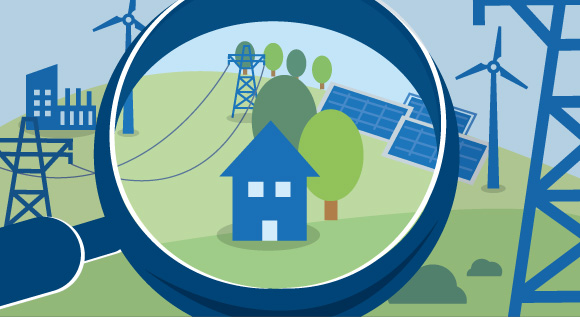What exactly is “combined heat and power”?
It’s difficult to talk about the energy transition without also discussing CHP or combined heat and power. CHP is often referred to as an ideal way of getting more out of our energy. But how exactly does it work? Read on to find out.
 © BMWi
© BMWiIt’s about getting the most out of energy several times over
It’s like when you’re driving: the engine is running, the car is moving, and the heating is generating heat. In other words, the energy contained in the fuel powering the car is not only keeping your car going, but also your fingers warm. Not all of the waste heat is lost; in fact, a fair share of it can be used.
That’s an example of combined heat and power (CHP). Just like your car, CHP installations are powered by fuel, which is used to generate mechanical power. This power is then turned into electricity, a process which also generates heat. So far, so good. But the special thing about CHP is that this heat is not left to dissipate, but used for purposes like heating. In other words, CHP makes it possible for the same fuel to be used several times over: it allows for greater efficiency and helps us bring down our overall carbon emissions.
Moving to cut carbon emissions on all fronts
The work to help us cut our carbon emissions is continuing across all fields. There are now CHP installations that can be powered by renewables, including biogas, bio ethanol, or timber – rather than coal, gas and other fossil fuels. This makes CHP all the more attractive when it comes to generating clean energy and using it to the full.
At up to 90 per cent, the overall efficiency of CHP installations is much higher than that of installations that generate nothing but electricity. Overall, these installations can help us cut down on the amount of fuel we use, simply by extracting both electrical and heat energy from the fuel they are powered with.
Large and small-scale installations
Yes, that’s right – CHP installations come in all shapes and sizes. A large number of utilities, for instance, operate large CHP installations to provide district heating to entire cities.
But there are also much smaller CHP installations used to power industrial companies or individual residential buildings. The main advantage of these small-scale installations is that they generate electricity and heat close to where it is needed. This eliminates the need for this electricity and heat to be transported to the consumer – a process that normally involves energy being lost.
CHP today and tomorrow
It may be interesting for you to know that we have a new law in Germany under which CHP is eligible for funding (the Combined Heat and Power Act). This is designed to help us cut down on our carbon emissions whilst we continue to use fossil fuels such as natural gas to generate electricity and heat.
In the coming years, we will be designing the framework for our future energy system, and CHP will also have a role to play in this. CHP technology and heating grids have long investment cycles. This means that we need to plan well ahead. The Federal Ministry for Economic Affairs and Energy has therefore launched its “Electricity 2030” debate, which will help us decide what steps we should take next. For more information, please click here.

